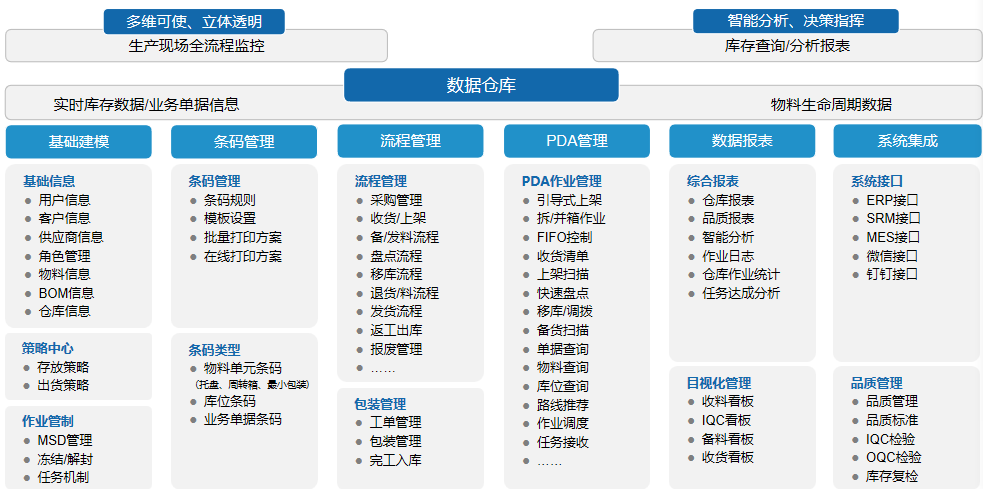WMS Functional architecture:

Features of the WMS solution:
Overall logistics system solution: This system achieves comprehensive management of the logistics center through seamless integration with the ERP system, logistics equipment (such as WCS), suppliers/customers, and logistics information portals. Supports multi-warehouse and multi-cargo owner mode, and has a mature fee collection model and precise fee collection calculation capability.
Applicable industries: This system is applicable to multiple industries such as food cold chain, third-party logistics, manufacturing, clothing logistics, pharmaceutical distribution, e-commerce, and industrial distribution, covering business areas including warehouse management, distribution management, transportation management, and supply chain management.
Key features: The system integrates the best business practices, has highly flexible process and business rule configurability, supports full barcode management, seamlessly integrates modern logistics equipment such as RF, electronic tags, and ASRS, and enhances operational efficiency and accuracy.
Functional Module: The system contains hundreds of functional modules, covering multiple aspects such as customer profiles, products, packaging, batch attributes, warehouse areas/locations, purchase orders, inventory balances, shipping orders, inbound notifications, inventory transfers, inventory adjustments, wave planning, receiving goods, inventory checks, inventory movements, pre-allocation/distribution, quality inspections, inventory freezes, safety stocks, and replenishment. Meet the specific needs of various industry applications.
Technical features:
High configurability: The system supports flexible process and business rule configuration, reducing implementation costs and enhancing the system's adaptability and scalability.
Full-process barcode management: By applying modern logistics equipment such as RF devices, electronic tags, and conveying and sorting lines, the barcoding of operation units, inventory locations within the warehouse, operation documents, and operation instructions is achieved, significantly enhancing operation efficiency and accuracy.
Integration with RFID technology: Through forward-looking functional design and technical support from a data interaction platform, seamless integration with logistics equipment such as RF, RFID, electronic tags, ASRS, and ERP systems is achieved.
Logistics distribution center business model: The system supports full-process management including warehousing, procurement, arrival, unloading, acceptance, counting, confirmation, shelving, order processing, labeling, receiving, closing, transaction history, freezing/releasing, movement, inventory dynamics, adjustment, transfer, inventory taking, replenishment, outbound, shipment, well closing, stoking, shipping, processing, etc.
Operation strategy and process planning: The system assists clients in establishing standard operating procedures (Sops), optimizing reasonable operation processes, and enhancing management capabilities, order execution efficiency, and productivity.
Implementation and Service:
Project implementation method: Adopt mature project implementation methods, including project initiation, knowledge training, business information collection, system configuration, customized development, user training, functional testing, integration testing, stress testing, end user training, on-site simulation exercises, launch preparation, system switching and post-launch support, etc., to ensure that customers can quickly obtain a return on investment.
Project control documents: Throughout the entire project, complete documents such as the overall project plan, communication plan, weekly reports, issue reports, business analysis reports, difference analysis reports, system configuration and customization reports, test plans and test reports, operation manuals, application systems, launch reports, and acceptance reports.
Development management and version management: Define and store internal system parameters for customized code during the project implementation process to ensure that version upgrades do not affect the use of the original customized content. The system interface fields can be customized, the data dictionary is open, and it supports user-defined queries and report development.
Training services: We offer comprehensive training services, including training at the initial stage of project initiation, advanced user training before system integration testing, end-user training during the system simulation and exercise phase, one-on-one guidance during the launch period, and regular problem review and usage guidance during maintenance.
After-sales service: We offer various maintenance service methods, including hotline or email services, on-site service by users, on-site service by service personnel, and remote communication services. Based on the definition of fault levels, different levels of service response times are provided, and system upgrade services are offered to customers.


